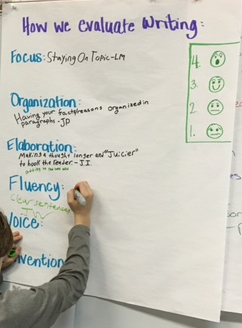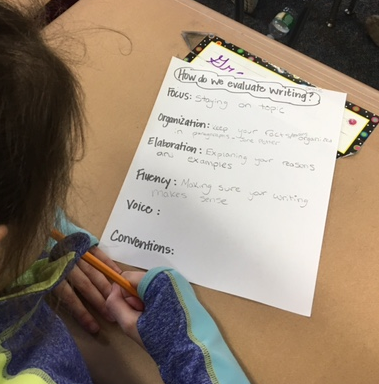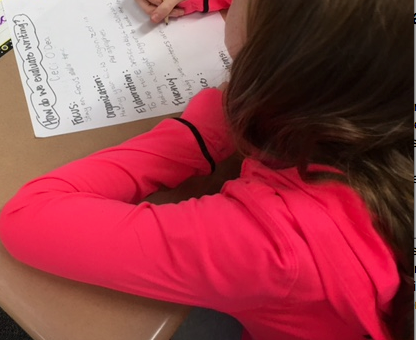Student Self-Assessment Strategies
Over the course of the year, I have watched my daughter’s level of engagement rise in the work she does for her high school English class. In her AP English class, she is asked to grade herself and present the evidence for her self-assessment to her teacher at the end of each marking period.
I have been trying to replicate this experience with some of the fifth graders in our district. The class has just completed the first argument essay within their Research-Based Essay unit, and they are getting ready to begin a second one on a different topic. Before they begin, I want them to evaluate themselves as researchers and writers and set some goals for the rest of the unit. Therefore, I talked to some of them about grading their own papers and thinking about their strengths and weaknesses.
Through our conversations, it became clear that the students were not sure how to clearly state their strengths as writers or their areas for improvement. We grade student writing with an analytic rubric that has indicators for six traits of writing: focus, organization, elaboration, fluency, voice, and conventions. Our students have seen these rubrics for three or four years, yet when I asked them what these traits really entailed, they weren’t sure.
I asked their teacher if I could try a new lesson with his class, and the next day, I presented them with a blank chart of how we evaluate writing. Each student got their own copy of the chart, and my instructions to them were to try to describe in their own words what is meant by each trait of writing. I told them that I could describe each trait, but my language might not make as much sense as their own language. I really wanted to create a chart that had definitions that the students understood. As I came across responses that would help everyone, I handed out markers and asked students to share their ideas on a master chart.

As the master chart developed, their own personal charts developed as well.


I emphasized to students to write only what made sense to them on their own paper. Everyone’s chart should look a little different, I said, but all of the students should end up with a tool that would help them evaluate their own writing. After about 15 minutes, we had a class chart that looked like this:

The only words I can take credit for on this chart are under Focus—“Everything in the paragraph goes along with the same idea.” The students came up with all the other indicators and even put their initials next to their ideas. The green faces on the right side of the chart indicate whether writers haven’t done too much within the trait (a “1”) all the way up to their doing an unbelievable job (a “4”).
The students’ next assignment was to self-assess their first essays. One student called me over to say that she was not sure about how to grade herself within the trait of fluency. On her own chart, she had very little written down for that trait. I suggested that she visit the classroom chart and see if there were other indicators that her classmates had written that would help her make decisions about her own writing. She took her own paper up to the front of the room and found two additional ideas about fluency. She was then able to decide on giving herself a 2+ for fluency. “I think in my next essay, I should try to have more transition words,” she said. I agreed. I might have been able to tell her that from just reading her essay, but the concept is much more powerful for her because she figured it out for herself. I can’t wait to see how her next essay goes!
I am always interested in ways to involve students in their own learning processes. Goals are important in all aspects of life, and at all ages. However, to set goals, we need to understand what we really want to achieve. Having students create their own set of indicators in language that they not only understand but actually come up with themselves will really help them be able to self-assess, set goals, and improve as writers and as learners.
https://choiceliteracy.com/article/student-self-assessment-strategies/

No comments:
Post a Comment